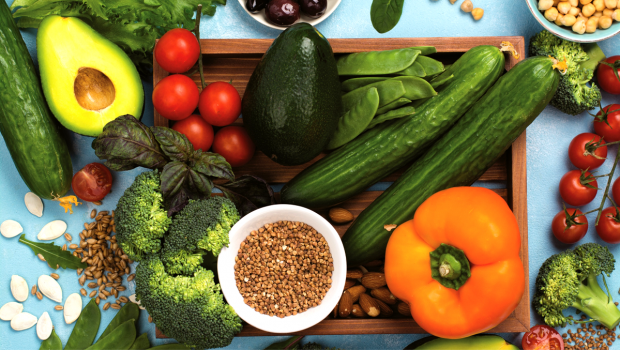Changing Our Diet to Cool the Climate
Good Food Choices Enable Global Health
by Judith Fertig
Three years ago, the New York Times added a new word to the world’s food vocabulary: Climatarian (n.) A diet whose primary goal is to reverse climate change. This includes eating locally produced food (to reduce energy spent in transportation), choosing pork and poultry instead of beef and lamb (to limit gas emissions), and using every part of ingredients (apple cores, cheese rinds, etc.) to limit food waste.
Changing our food choices to support this model can have a ripple effect. Researchers at the University of California, Santa Barbara, in a 2017 study published in the journal Climatic Change, looked at how diets impact personal health, the healthcare system and climate. They found that adopting a more plant-based diet reduces the relative risk of coronary heart disease, colorectal cancer and Type 2 diabetes by 20 to 40 percent. National annual health care costs could drop from $93 billion to $77 billion. Direct greenhouse gas emissions could annually drop 489 to 1,821 pounds per person.
Such an approach involves considering the related water usage, greenhouse gas emissions and carbon footprint—the energy required to cultivate, harvest and transport food—plus processing associated food waste. Here are some top choices.
Foods that Go Easy on Water
Hydroponic greens are hands-down winners. The Shelton Family Farm, near Whittier, North Carolina, weekly produces 10,000 to 12,000 heads of hydroponically grown Bibb lettuce. The controlled environment and carefully engineered nutrient delivery systems maximize all resources.
“It’s an enclosed system that runs 24/7, and it’s highly efficient from a waterusage standpoint because we recycle the water,” says William Shelton Jr., a fourthgeneration family farmer. “The only water that’s actually consumed is what’s taken up and transpired through the plants.” In a moderate climate, energy costs to recycle the water and keep the plants at an even temperature are moderate, as well.
Dry-tilled heirloom tomatoes, okra, melons and quinoa are drought-tolerant and only use available rainfall.
Foods that Go Easy on Greenhouse Gases
Plants beat meat. “Livestock farming produces from 20 to 50 percent of all manmade greenhouse gas emissions,” says nutritionist and climate activist Jane Richards, of GreenEatz, in Mountain View, California. “You can reduce your footprint by a quarter by cutting down on red meats such as beef and lamb.”
An exception is the vegetarian staple of rice. According to researchers at Project Drawdown, a climate solutions organization in Sausalito, California, rice cultivation is responsible for at least 10 percent of agricultural greenhouse gas emissions and up to 19 percent of global methane emissions. New farming techniques, like mid-season draining of the rice paddies, could cut methane emissions by at least 35 percent.
Richards notes, “Meat, cheese and eggs have the highest carbon footprint; fruit, vegetables, beans and nuts, much lower. The carbon footprint of a vegetarian diet is about half that of a meat-lover’s diet.”
Root crops such as carrots, radishes, potatoes and beets have a lower carbon footprint than above-ground plants due to less food waste. A beautiful beet is easier to grow than a bell pepper that blemishes more easily.
Seasonal, regional fruit, vegetables, herbs and honey have a lighter carbon impact because they are transported shorter distances. Usually what grows best in a region and is consumed locally is also best for the climate.
Foods naturally suited to their environment grow and taste better, and are packed with more nutrients, reports Sustainable Table, an educational nonprofit that builds healthy communities through sustainable eating habits (SustainableTable.org).
Hopeful Developments
New agricultural developments can also benefit our climate environment. According to Project Drawdown research, perennial grains and cereals could be pivotal in reaching soil, carbon and energy targets.
The Land Institute, in Salina, Kansas, has been working with the Rodale Institute, in Berks County, Pennsylvania, to develop a perennial wheat that would not have to be planted from seed each year. This would save soil, carbon and both human and machine energy.
Kernza, a new perennial grain proven to prosper in natural grasslands like the Great Plains, is not yet widely distributed. Maria Speck, author of Simply Ancient Grains, advises, “With up to 15-foot-long roots, it can be harvested for five years and uses less fertilizer than conventional wheat. Kernza tastes almost like a cross between rice and wheat—sweet, grassy, mesmerizing.”
Michael Pollan, author of Food Rules: An Eater’s Manual and creator of the film Food, Inc., suggests we keep it simple: “Eat food, not too much, mostly plants.” Climatarians would add another guideline—eat as locally as possible.
Judith Fertig writes cookbooks plus foodie fiction from Overland Park, KS (JudithFertig.com).
Image: Ekaterina Markelova/Shutterstock.com
<












